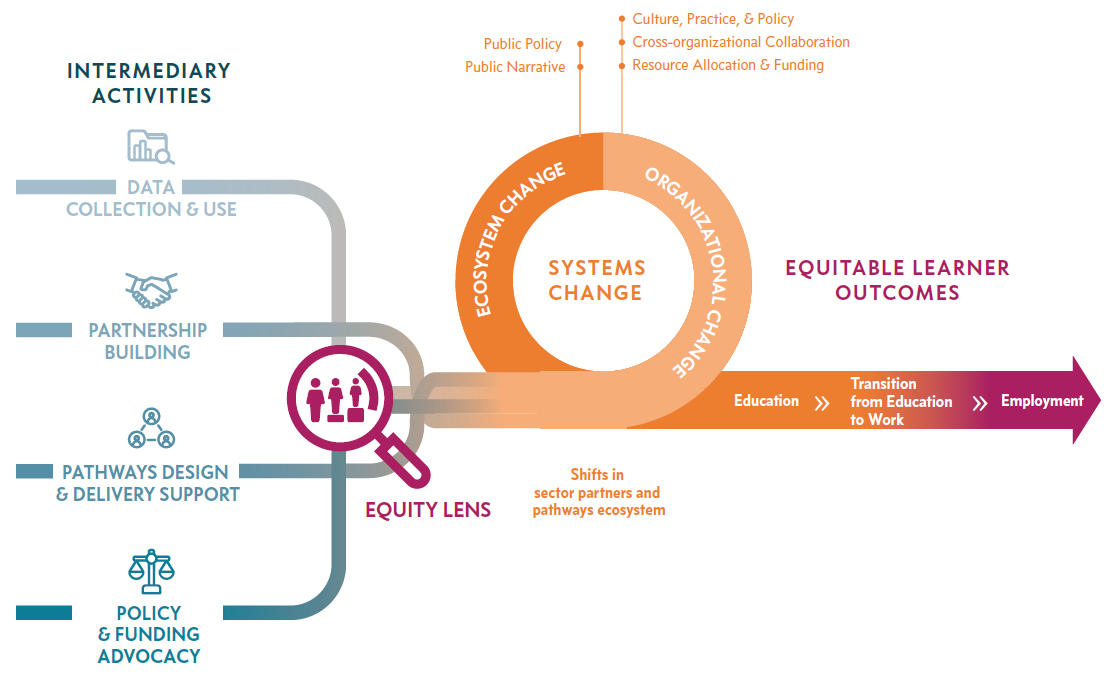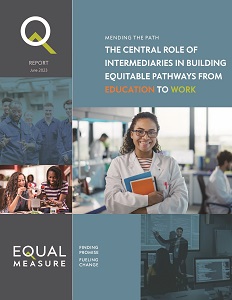by Kimberly Braxton, Director, Equal Measure
How can pathways intermediaries support K–12, postsecondary, and workforce partners in centering equity as they work across sectors to “Mend the Path”?
Our report, The Central Role of Intermediaries in Building Equitable Pathways from Education to Work, synthesizes Equal Measure’s learnings over the course of our evaluation engagement conducted between 2019 and 2022. Our project sought to elevate the work of intermediaries and their influence on local, regional, and state pathways ecosystems. We aspired to make clear the essential activities intermediaries lead to advance systems change within their ecosystems, as well as the expected impact of these activities. Among other sources, our findings draw from the Equitable Pathways Intermediary Framework, a document created with intermediaries, and from the results of a 2022 survey administered to intermediary staff and their partners.
This is the third and final release in the series of insights and tools grounded in the work of intermediaries participating in the Building Equitable Pathways Community of Practice. Pathways intermediaries are forging a new system in which K–12, postsecondary, and workforce partners collaborate to create conditions that lead to more learners of color and learners experiencing poverty completing education and securing good jobs. For more about the Community of Practice, facilitated by JFF, visit the JFF website.
How can intermediaries apply an equity lens to pathways building?
Attention to equity must be deeply embedded across all activities to build pathways that uplift learners of color and learners experiencing poverty. The Equitable Pathways Intermediary Framework and survey results draw attention to the necessity of intermediaries and their partners to adopt equity-centered mindsets and practices. Equity in this context refers to the quality of pathways activities and system changes in working to disrupt organizational and institutional status quos and achieve fairness and justice for members of historically marginalized communities, including communities of color and low-income communities. It also refers to closing gaps (e.g., achievement, attainment, income) such that race, ethnicity, or class do not predict one’s success. Equity must be prioritized in the work of pathways intermediaries to promote the types of changes within organizations and in the broader pathways ecosystem that enable equitable learner outcomes.
Applying an equity lens means that the pathways intermediary organization brings it up across all aspects of work—for example, in the shared vision of the partnership, the lens through which pathways are designed and partnership activities are led, and in staff conversations within the intermediary organization. According to JFF:
“Early into the Community of Practice, it became clear that the racial equity lever must be prioritized within and across each lever to catalyze real change in pathways systems. … [W]e reoriented our approach to better leverage data and policy as tools for amplifying racial equity in pathways.”
The figure below presents the 11 equity-specific activities in the Equitable Pathways Intermediary Framework.
What does it look like when an intermediary applies an equity lens?
| Data Collection and Use | When developing local labor market pathways, intermediary applies understanding of the goals, assets, needs, and systemic barriers faced by learners of color and learners experiencing poverty. Intermediary disaggregates sector data by race, ethnicity, and other relevant demographic characteristics to identify needs and ensure career pathways have an equitable impact. |
| Partnership Building | Intermediary communicates to sector partners the value of partnerships across K–12, postsecondary, and employers in creating more equitable pathways.Intermediary builds shared understanding about learner needs and commitment to prioritize learners of color and those experiencing poverty. |
| Pathways Design and Delivery Support | Intermediary incorporates input and feedback from learners and families in the development of curricula, program design, and learner experiences. Intermediary develops culturally responsive and equity-focused quality standards for career pathways programming providers. Intermediary provides culturally responsive and equity-focused training and technical assistance to sector partners. Intermediary connects partners to human service providers who can help learners successfully complete career pathways programs. |
| Policy and Funding Advocacy | Intermediary implements a policy agenda to change local, state, and/or federal policies to improve equitable pathways for learners of color and learners experiencing poverty. Intermediary elevates the voices, experiences, and perspectives of learners of color and learners experiencing poverty to influence policymakers and policy advocates. Intermediary works to align public and private funding to strategies that advance equitable outcomes. |
Equity must be prioritized in the work of pathways intermediaries to promote the types of changes within organizations and in the broader pathways ecosystem that enable equitable learner outcomes.
As this series concludes, thank you again to all the staff and partners of the intermediary organizations whom we engaged in the evaluation and the Building Equitable Pathways (BEP) support partners (JFF, the Center for Regional Economic Competitiveness, Evan James Consulting, the Center for Innovation in Education, and Education First).
Deep appreciation goes out to all my current and former Equal Measure colleagues serving on the BEP evaluation team: Robert Roach, Dan Tsin, Steph Skinner, Justin Piff, Catherine Park, and Matthew Closter. Our communications team members played a significant role in producing the content and resources, and they include Carise Mitch, Carissa Cress, and Seth Klukoff.

